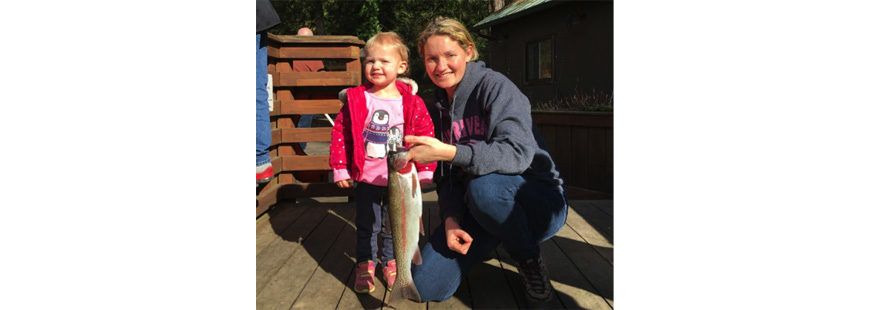Photo: two-year-old Haylee and mom Leeann Hubbard with Haylee’s first trout
The Association of Northwest Steelheaders just completed its 3rd annual Family Fish Camp at beautiful Camp Angelos on the banks of the Sandy River in Troutdale, Oregon. Of course, we ordered up a nice batch of weather to go along with some monster trout donated by Desert Springs Trout Farm and a slew of 8″ to 10″ rainbows by Brian Trout Ranch. Pulling off the event is a feat in and of itself; big thanks to Allison Dobscha for making it all happen.
Even after leading the Steelheaders for the last four years, it’s utterly amazing to me how the “troops” roll out the carpet—with sponsorships from KastKing Rods, Tom McCall Chapter of the NW Steelheaders, Camps for Kids, National Wildlife Federation, Saling Foundation and the Jubitz Family Foundation—to ensure the next generation of conservationists know why our natural resources are worth protecting. And as if that wasn’t impressive enough, the number of volunteers who come cook, clean and teach is breathtaking. These people want a future for our children, and so many work so hard to make sure that happens. I may have the greatest job in the world!
My job is not without its frustrations, however. The more I delve into the politics of fishing, the more I understand the need for a conservation movement. Our fish populations are in the state of depression that they are because we were not keeping watch. Even though management has improved in the last two decades, we must not be yelling loud enough, our messaging might be off, or we’re spending too much time bickering between ourselves on what’s right for the resource, because not enough people are paying attention to the bigger fish that need to get fried.
This is what makes the Marine Fish Conservation Network so unique. We are a network of sport and commercial fishing interests, along with certified smarties in other sectors, such as the slow food movement, working together to achieve a common set of goals. The Network has peaked and valleyed, but every time the Magnuson-Stevens Act is up for reauthorization, we seem to all come together to ensure the Congressional sausage (otherwise known as legislation) that gets made translates into more sand dabs (or insert your favorite marine fish here) so that sport and commercial sectors, along with the rural communities they support, can benefit. Priority one is to ensure the next generation of angler or commercial fisherman has the same opportunities we did.
Protecting our natural resources for future generations is often an uphill battle. Salmon is a prime example of how our efforts don’t always work out. We’re seeing a dramatic downturn in salmon populations right now even though salmon are somewhat governed under MSA. (I say somewhat as salmon are governed under about every agency it seems.) I’m not sure any law will reverse that, particularly for the long-term.
Salmon fall under so many different governing jurisdictions because of their broad home range. A salmon born in the Snake River in Idaho migrates through numerous hydropower systems and stagnant reservoirs before it even gets to the ocean. The mouth of the Columbia River, with its predators (including fishermen) and wildly fluctuating ocean productivity, can determine the success of a salmon’s spawning run back home.
Groundfish are a different beast, however. Many rockfish species live their entire lives within a few miles of where they were born. They’re not susceptible to the rigors of species with broad home ranges. Simply put, if we mess up management of such a simple-minded species such as groundfish, we really should be wearing the dunce hat in the corner of the classroom. Either that, or there’s some really powerful special interests that have steamrolled us while we weren’t looking.
Which brings me back to our legacy. Many of us weren’t raised knowing how to fight for our natural resources. Forty years ago we had it fairly good; we had no real reason to go toe-to-toe. The Steelheaders, however, were “born” 58 years ago in an effort to sweep steelhead into a sportfishing category versus a food fish category, effectively taking them off the menu for the gillnet fleet to harvest. That battle was won under the leadership of Republican Governor Tom McCall (note the name of Steelheader chapter mentioned earlier as the Tom McCall Chapter). Republicans historically led the charge on conservation; these days it’s Democrats. Regardless, MANY Republicans AND Democrats should come together to pass laws that ensure a future for hunters, anglers and those who just wish to view wildlife – all critical constituencies that fund the conservation missions of our collective natural resource agencies.
It’s time that we come together again, not as Democrats or Republicans, but as US citizens, to ensure that the fishing stories we tell today are told by our children’s children tomorrow. In the face of the many threats that our oceans and fisheries confront, we’re going to need to build an effective conservation army. Join us in winning a future for all our families.



Conservation is an obligation we all share.
But conservation should not be confused with protectionism. An OY(optimum yield) has been
Has been established long ago. This is an amount
That provides an adequate amount of the resource
To replace it’s self. Then a MSY is established
(Maximum sustainable yield).normally around 80
Percent of the OY. Then this amount is split 49/51
Between recreational and commercial interest.
Using this method there is no reason the fish won’t
Continue for future generations.